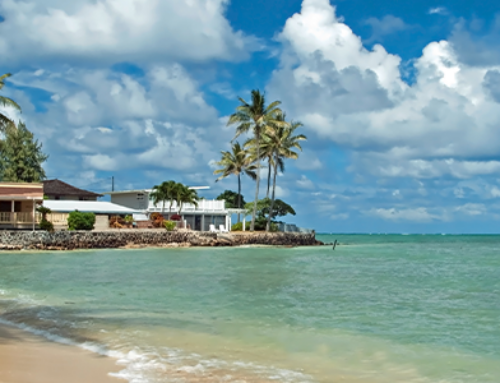Moving to a retirement community represents a transition. Some seniors look forward to embracing a new lifestyle and turning over things like home maintenance to someone else. Others might feel nervous that they won’t “fit in” or that they’ll miss the comfort of their own home.
To help you create a smooth transition for yourself or a loved one, we’ll take some of the guesswork out of the process with our nine tips for finding the best retirement community in Hawaiʻi. These tips will help you focus your search and get clarity on what’s really important so you or your loved one can find the Hawaiʻi senior community that’s a perfect fit.

Tip #1: Zero In on the Community That Fits Your Needs
As the percentage of 65+ adults in the country continues to grow, the types of senior living communities have grown, too. If you’re just starting your search, the different facility types, services, and amenities can feel overwhelming.
Below, we’ve listed the six major categories of senior living communities. Read a little about each, so you can start to narrow down your search for the right community:
Planning for the Future
As you consider the different types of communities available, keep your changing needs in mind. Transitions can be difficult as adults get older. Communities that offer multiple levels of care at a single location can offer a simpler transition when more assistance is needed.

Tip #2: Evaluate Nearby Medical Care
No matter what kind of community you decide on, easy access to medical care is critical. You don’t want have to travel long distances for preventative and wellness care, treatment of any ongoing medical issues—or more urgent assistance if you’re sick or injured.
As you evaluate communities, check if they have any medical care available within. If not, how far will you have to travel to see your doctor? If you have to change doctors, is there one accepting new patients nearby? Make sure to check for internists/primary care physicians, dentists, eye doctors and any specialists that you or your partner/spouse need to see.
The key here is ease of access. While it may not be a huge effort to drive 30 minutes to see your doctor now, it will get increasingly difficult in the future. Look for a community that makes it easy for you to connect with the health care you need now—and into the future.

Tip #3: Consider the Weather
Maybe that sounds like strange advice in a place like Hawaiʻi, where the weather is famously beautiful all year-round. However, if you don’t live here now, you’ll soon discover Hawaiʻi’s diverse microclimates. On the Big Island, for example, hot and sunny Kailua-Kona feels very different from lush and rainy Hilo, which feels very different from crisp and breezy Waimea.
You might crave that sun and heat, so Kailua-Kona might be perfect. But you also may need to run the air conditioning most of the time, which will impact your electricity bill (if you live in a community where you’re responsible for your own utilities). Conversely, if you settle in a place like Hilo, you might miss the sunshine—or find the Waimea nights just a bit too cool.
The bottom line? Don’t assume that all of Hawaiʻi is the same, weather-wise. Get to know your community well, including its dominant weather pattern. That way, you’ll know exactly what to expect.

Tip #4: Find a House That Feels Like a Home
For some seniors, moving to a retirement community means giving up a cherished home full of happy memories. As you look at new places to live, think about the things that could make your new living situation feel like more than just a house.
For example:
- Do you want a detached dwelling, or would you prefer an apartment?
- Is your new space big enough to accommodate your favorite furnishings and décor?
- Are there any restrictions on what furniture you can bring? Will you be able to keep your beloved dining room table?
- How much will you have to downsize?
- Does your new home have enough storage? Or will you have to get rid of more than you feel comfortable?
There’s no question—moving to a retirement community means a change. However, when you’re able to make your space your own, that change will feel less dramatic.
Moving Tip: Take Measurements
If you’re living in a community that allows you to bring your own furniture, make sure you measure everything—your new space and your furniture. We’ve moved several customers who overestimated how much space they’d have, only to discover their furniture wouldn’t fit on Moving Day.
Keep your tape measure handy when you tour your potential new home and sketch out a potential layout. As a bonus, your crew can put your furniture right where you want it, no muss, no fuss.

Tip #5: Get to Know the Other Members of the Community
Many seniors choose to move to a retirement community for the social aspect—the chance to meet people in the same phase of life who want to enjoy their golden years.
Finding a group of people whose company you enjoy will make this phase of your life much more pleasant—and it can keep you healthier, longer. In fact, a study from the National Academies of Sciences, Engineering, and Medicine suggests that social isolation can increase a person’s risk of premature death from all causes. In other words, finding neighbors you love spending time with is critical to your health and well-being.
What’s the best way to find a community you fit into? Ask if you can eat a meal with residents or participate in an activity. See how the community members treat each other, and see if you can see yourself filling one of the chairs around the table on a more permanent basis. If the community you’re looking at doesn’t offer meals or activities, spend some time walking the grounds and talk to the people you meet. You’ll start to get a good sense for your new neighbors.
And, finally, go with your gut. It’s often right.

Tip #6: All Amenities Are Not Created Alike
While you’re evaluating your potential new neighbors and friends, make sure take in any of the community’s other services, especially 1) their food, 2) their roster of activities, and 3) their community facilities.
When it comes to food, some communities offer communal meals or food outlets. If that’s the case, make sure to take in a meal. (Or two, if you can make a second visit!) Of course, make sure you like the food served—but don’t forget to watch how the community interacts at meal time, as we suggested above.
Along those same lines, make sure to evaluate the available amenities and activities. Staying active—physically and mentally—will make a huge difference in your health as you age. Are the activities things you’d enjoy? Can you see yourself participating? Are the facilities easy to access and are they well maintained?
All of these will ultimately contribute to your quality of life, so evaluate them carefully.

Tip #7: Don’t Forget to Look Beyond the Community
While you’re still active and mobile, you’ll want to take advantage of everything that’s available to you beyond your retirement community. As you zero in on your final pick, make sure the community you choose is convenient to the things that you love. Maybe that’s a walk on the beach, a movie in the theater, a meal out—whatever makes you happy.
In other words, don’t forget to look outside your retirement community before you make a final selection. The older you get, the less likely you’ll be to travel far from home. Choose one with easy access to amenities and activities that matter to you

Tip #8: Evaluate the Financials Carefully
For many retirees, concern about the cost of their retirement community tops their list.
When it comes to making a final choice, it’s vitally important to understand all the costs you might be responsible for. In other words, what’s included in the overall monthly cost, and what’s not? Adding up all of those expenses—and comparing them to the cost of aging in place (i.e., staying in your own home, if that’s an option)—will offer some clarity. It will also help you compare apples-to-apples costs so you can know with certainty which one fits your budget.
Note: If you’re looking at a continuing care retirement community (CCRC), their contracts can be notoriously difficult to understand. It’s worth consulting with a lawyer before you sign anything.

Tip #9: For Profit vs. Non Profit—Know the Difference
Finally, you may also want to consider whether your retirement community is run as a for-profit or a non-profit organization.
The debate between for-profit and non-profit healthcare models is a continuing one, with proponents on both sides. Some non-profits argue that, instead of providing returns to investors, they reinvest in their staff and their facilities. Additionally, some non-profit CCRCs offer benevolence funds that assist residents who have outlived their savings.
Ultimately, it’s good to be aware of the difference—and to ask to vet the financials of any facility you’re considering so you can assess their priorities and their stability.
Spending Your Golden Years in the Right Hawaiʻi Retirement Community
Hawaiʻi offers plenty of advantages for retirees—and there are few places in the world that can top Hawaiʻi’s unique natural beauty. To ensure that you enjoy your golden years in Hawaiʻi, consider these nine tips as you search for the right retirement community. With these in mind, you’ll whittle down the options and find the perfect spot for you.
Need some help moving into your new retirement community? We’ve helped seniors with mainland moves, interisland moves, and local moves. Our crew would be happy to help you get settled in your new home. Just reach out for a quote to get started.
Tell us about your move!



